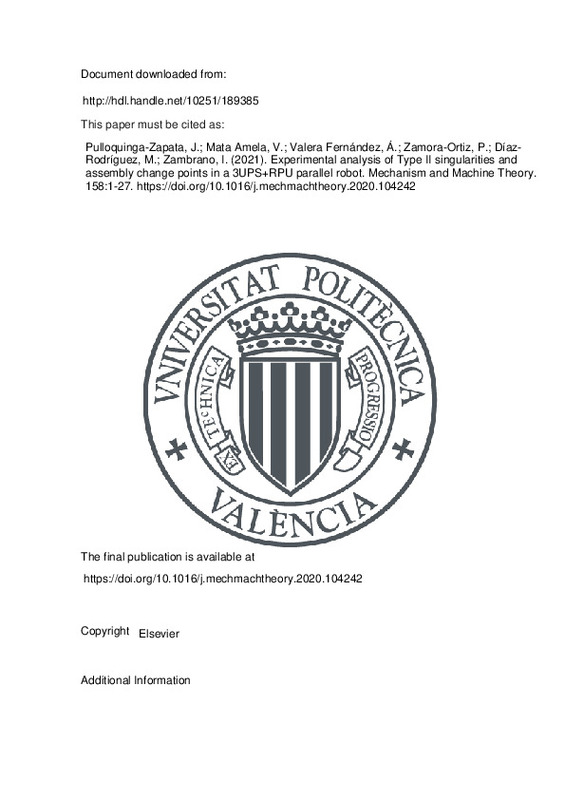JavaScript is disabled for your browser. Some features of this site may not work without it.
Buscar en RiuNet
Listar
Mi cuenta
Estadísticas
Ayuda RiuNet
Admin. UPV
Experimental analysis of Type II singularities and assembly change points in a 3UPS+RPU parallel robot
Mostrar el registro sencillo del ítem
Ficheros en el ítem
| dc.contributor.author | Pulloquinga-Zapata, José
|
es_ES |
| dc.contributor.author | Mata Amela, Vicente
|
es_ES |
| dc.contributor.author | Valera Fernández, Ángel
|
es_ES |
| dc.contributor.author | Zamora-Ortiz, Pau
|
es_ES |
| dc.contributor.author | Díaz-Rodríguez, Miguel
|
es_ES |
| dc.contributor.author | Zambrano, Ivan
|
es_ES |
| dc.date.accessioned | 2022-11-07T19:01:43Z | |
| dc.date.available | 2022-11-07T19:01:43Z | |
| dc.date.issued | 2021-04 | es_ES |
| dc.identifier.issn | 0094-114X | es_ES |
| dc.identifier.uri | http://hdl.handle.net/10251/189385 | |
| dc.description.abstract | [EN] Parallel robots (PRs) have singular configurations where the robot gains at least one degree-of-freedom and loses control. Theoretically, such singularity occurs when the Forward Jacobian-Matrix determinant becomes zero (Type II). However, actual PRs could lose control owing to Type II singularities for determinant values near zero, but not zero, because manufacturing tolerances introduce errors that are complex to model due to their low repeatability. Thus, using an actual 3UPS+RPU PR, this paper presents three contributions: i) a proximity detection index for Type II singularities based on the angle between two Output Twist Screws. The index can identify which kinematic chains contribute to the singularity. ii) an experimental benchmark to study Type II singularities. iii) PR configurations where the proposed index is zero and the Forward Jacobian determinant is not. In this last configuration, the findings show that the actual robot is unable to handle external actions applied to the PR. | es_ES |
| dc.description.sponsorship | This work was supported by the Spanish Government [Integracion de Modelos Biomecanicos en el Desarrollo y Operacion de Robots Rehabilitadores Reconfigurables, DPI2017-84201-R-AR]. It was also supported in part by Escuela Politecnica Nacional of Quito, [Control adaptativo basado en inteligencia artificial aplicado a un sistema mecatronico fundado en un robot paralelo para la diagnosis y rehabilitacion, PIMI-1504] | es_ES |
| dc.language | Inglés | es_ES |
| dc.publisher | Elsevier | es_ES |
| dc.relation.ispartof | Mechanism and Machine Theory | es_ES |
| dc.rights | Reconocimiento - No comercial - Sin obra derivada (by-nc-nd) | es_ES |
| dc.subject | Singular configuration | es_ES |
| dc.subject | Parallel robot | es_ES |
| dc.subject | Virtual power | es_ES |
| dc.subject | Screw theory | es_ES |
| dc.subject | Assembly modes | es_ES |
| dc.title | Experimental analysis of Type II singularities and assembly change points in a 3UPS+RPU parallel robot | es_ES |
| dc.type | Artículo | es_ES |
| dc.identifier.doi | 10.1016/j.mechmachtheory.2020.104242 | es_ES |
| dc.relation.projectID | info:eu-repo/grantAgreement/AEI/Plan Estatal de Investigación Científica y Técnica y de Innovación 2013-2016/DPI2017-84201-R/ES/INTEGRACION DE MODELOS BIOMECANICOS EN EL DESARROLLO Y OPERACION DE ROBOTS REHABILITADORES RECONFIGURABLES/ | es_ES |
| dc.relation.projectID | info:eu-repo/grantAgreement/EPN//PIMI-1504/ | es_ES |
| dc.rights.accessRights | Abierto | es_ES |
| dc.description.bibliographicCitation | Pulloquinga-Zapata, J.; Mata Amela, V.; Valera Fernández, Á.; Zamora-Ortiz, P.; Díaz-Rodríguez, M.; Zambrano, I. (2021). Experimental analysis of Type II singularities and assembly change points in a 3UPS+RPU parallel robot. Mechanism and Machine Theory. 158:1-27. https://doi.org/10.1016/j.mechmachtheory.2020.104242 | es_ES |
| dc.description.accrualMethod | S | es_ES |
| dc.relation.publisherversion | https://doi.org/10.1016/j.mechmachtheory.2020.104242 | es_ES |
| dc.description.upvformatpinicio | 1 | es_ES |
| dc.description.upvformatpfin | 27 | es_ES |
| dc.type.version | info:eu-repo/semantics/publishedVersion | es_ES |
| dc.description.volume | 158 | es_ES |
| dc.relation.pasarela | S\426323 | es_ES |
| dc.contributor.funder | AGENCIA ESTATAL DE INVESTIGACION | es_ES |
| dc.contributor.funder | Escuela Politécnica Nacional, Ecuador | es_ES |
| dc.subject.ods | 03.- Garantizar una vida saludable y promover el bienestar para todos y todas en todas las edades | es_ES |
| dc.subject.ods | 08.- Fomentar el crecimiento económico sostenido, inclusivo y sostenible, el empleo pleno y productivo, y el trabajo decente para todos | es_ES |







![[Cerrado]](/themes/UPV/images/candado.png)

